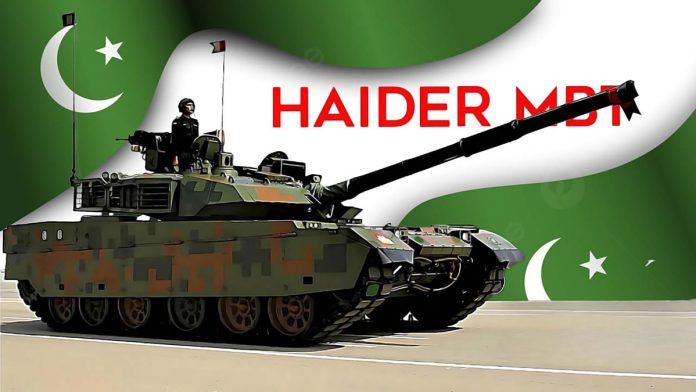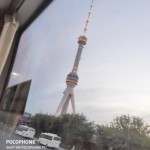Syed Samiullah
The Haider Main Battle Tank (MBT) is Pakistan’s latest development, produced by Heavy Industries Taxila (HIT) for the Pakistan Army. It was first revealed at the International Defense Exhibition (IDEX) 2023 in Abu Dhabi, UAE, and was formally unveiled on March 6, 2024, at HIT. The unveiling ceremony was attended by senior officials, including Chief of Army Staff (COAS) General Asim Munir, as announced by the Pakistan Armed Forces’ Inter-Services Public Relations (ISPR).
The Haider MBT is named after Hazrat Ali Bin Abi Talib (R.A.), the fourth Islamic Khalifa e Rashid, showcasing the prowess of Pakistan’s defense sector. This tank represents a significant advancement in Pakistan’s indigenous defense manufacturing capabilities.
Technical specifications and armament
The Haider MBT follows a conventional design, with the driver seated at the front center of the hull, the turret in the middle, and the engine at the rear. The tank has a crew of three: a driver, commander, and gunner. It is equipped with a 125 mm smoothbore gun with automatic loading capabilities, a 7.62 mm coaxial machine gun, and a remotely operated weapon system (ROWS) featuring a 12.7 mm machine gun. The tank carries a total of 38 rounds and is designed to handle a variety of ammunition types, including armor-piercing fin-stabilized discarding sabot (APFSDS), high explosive (HE), high explosive anti-tank (HEAT), and anti-tank guided missiles. In both design and functionality, it closely resembles the VT4, a modernized Chinese main battle tank (or MBT-3000) built by Norinco for export.
Advanced armor and protection systems
The Haider tank’s armor on the turret and the hull is a combination of composite, reactive, and spaced armor. Composite armor consists of layers of materials such as ceramics, metals, and polymers that work together to resist penetration by projectiles. Reactive armor uses explosive charges to disrupt and deflect incoming projectiles, while spaced armor consists of two layers with a gap between them that helps absorb the energy of incoming projectiles. The front of the hull is fitted with an ERA (Explosive Reactive Armor) package.
The tank also features a laser warning system to alert the crew when targeted by laser-guided weaponry. Compared to the VT4, the Haider’s ERA and other protective measures are more efficient and capable of meeting specific operational requirements.
Fire control and targeting capabilities
The Haider MBT is equipped with an advanced fire control system that includes thermal imagers, stabilized sights for both the gunner and commander, and a ballistic computer. These features enable precise target acquisition and engagement, even in challenging battlefield conditions. The thermal imaging sight allows the detection of heat signatures at long distances, while the panoramic commander’s sight offers a 360-degree view of the surroundings.
Mobility and engine specifications
The Haider tank is powered by a four-stroke turbocharged, electronically-controlled diesel engine, producing 1,200 horsepower. This engine is paired with a hydro-mechanical automatic transmission, allowing the tank to achieve a maximum road speed of 70 km/h and a cruising range of 500 km. The suspension system features torsion bars with hydraulic shock absorbers on the first and last road wheels, ensuring stability and maneuverability on diverse terrains.
Operational and strategic implications
The introduction of the Haider MBT signifies Pakistan’s strategic shift towards heavier, more armored tanks, moving away from the lightweight designs that have dominated its armored corps. This shift is highlighted by a comparative analysis of the Haider with other potential tanks, such as the Ukrainian Oplot-M and the Turkish Otokar Altay, indicating an interest in heavier, technologically advanced MBTs.
Industrial and technological advancements
The development of the Haider Main Battle Tank (MBT) signifies a major milestone in Pakistan’s quest for self-reliance in defense manufacturing. The partnership with Norinco and local industries has enabled the transfer of crucial technology and expertise, allowing the Heavy Industries Taxila (HIT) to integrate advanced subsystems, including the power plant, electronics, cannon, munitions, and protection suites. This collaboration not only boosts the operational capabilities of the Pakistan Army but also strengthens the local defense industry’s ability to support and develop these systems domestically.
Future prospects
Looking ahead, the Haider MBT has the potential to lay the groundwork for further advancements in Pakistan’s armored capabilities.
Incorporating active protection systems like the Akkor, which can intercept incoming guided missiles, and developing a network-centric warfare environment could transform the Haider into a “smart tank” comparable to the South Korean K2 Black Panther. Such enhancements would significantly improve the tank’s situational awareness and operational effectiveness on the modern battlefield.
Conclusion
The Haider MBT represents a significant achievement in Pakistan’s defense sector. Its advanced features, robust protection, and superior firepower make it a formidable asset for the Pakistan Army. As the country continues to develop and integrate cutting-edge technologies, the Haider MBT stands as a testament to Pakistan’s growing capabilities in indigenous defense manufacturing and its strategic move towards more heavily armored combat vehicles.
The author is Head of the Research Department at Rabita Forum International (RFI) and the Associate Editor of Monthly Interaction.







